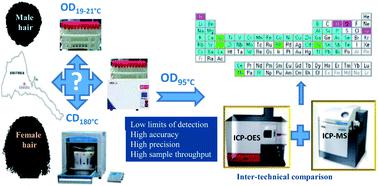当前位置:
X-MOL 学术
›
Anal. Methods
›
论文详情
Our official English website, www.x-mol.net, welcomes your
feedback! (Note: you will need to create a separate account there.)
A new rapid treatment of human hair for elemental determination by inductively coupled mass spectrometry
Analytical Methods ( IF 2.7 ) Pub Date : 2020-03-18 , DOI: 10.1039/c9ay01871a Maria Luisa Astolfi 1, 2, 3, 4 , Carmela Protano 2, 3, 4, 5 , Elisabetta Marconi 2, 3, 4, 5 , Lorenzo Massimi 1, 2, 3, 4 , Marco Brunori 2, 4, 6, 7 , Daniel Piamonti 2, 4, 6, 7 , Giuseppe Migliara 2, 3, 4, 5 , Matteo Vitali 2, 3, 4, 5 , Silvia Canepari 1, 2, 3, 4
Analytical Methods ( IF 2.7 ) Pub Date : 2020-03-18 , DOI: 10.1039/c9ay01871a Maria Luisa Astolfi 1, 2, 3, 4 , Carmela Protano 2, 3, 4, 5 , Elisabetta Marconi 2, 3, 4, 5 , Lorenzo Massimi 1, 2, 3, 4 , Marco Brunori 2, 4, 6, 7 , Daniel Piamonti 2, 4, 6, 7 , Giuseppe Migliara 2, 3, 4, 5 , Matteo Vitali 2, 3, 4, 5 , Silvia Canepari 1, 2, 3, 4
Affiliation

|
Advancements in sample preparation for performing elemental analysis are coming from the dissemination of microwave-assisted procedures, but there is still room for improvements by looking for fast and easily applicable procedures. In the present study, open-vessel digestion sample treatment (19–21 °C or 95 °C) was compared with closed-vessel microwave-assisted digestion (180 °C). Detection and quantification limits, accuracy, precision, residual carbon content, and residual acidity were quantified with certified and in-field hair samples. Human hair samples (0.02 g) were digested with HNO3/H2O2 (2 : 1) in an open vessel heated to 95 °C. The residual carbon content was <87 ± 6 mg L−1 and the residual acidity was <0.86 ± 0.10 mol L−1 in the final digested samples. The elements (Al, As, B, Ba, Be, Bi, Ca, Cd, Ce, Co, Cr, Cs, Cu, Fe, Ga, K, La, Li, Mg, Mn, Mo, Na, Nb, Ni, P, Pb, Rb, Sb, Se, Si, Sn, Sr, Te, Ti, Tl, U, V, W, Zn, and Zr) were determined with a quadrupole inductively coupled plasma mass spectrometer equipped with a collision–reaction interface. A detection limit of 0.00002–30 mg kg−1, a (repeatability of <11%, an intermediate precision of <13%, a trueness bias of −4 to 9%, and a recovery of 90–110% for all the elements except for Cr = 65% and Fe = 79% were observed. The results indicate that the proposed method is suitable for routine multi-elemental analysis in human hair studies.
中文翻译:

一种新型快速处理人发的元素,通过电感耦合质谱法测定
微波辅助程序的传播使用于进行元素分析的样品制备方面的进步,但是通过寻找快速且容易应用的程序,仍有改进的空间。在本研究中,将开放式容器消化样品处理(19–21°C或95°C)与封闭式容器微波辅助消化(180°C)进行了比较。检测和定量极限,准确性,精确度,残留碳含量和残留酸度均通过认证的和现场毛发样品进行定量。在加热至95℃的敞口容器中,用HNO 3 / H 2 O 2(2∶1 )消化人的头发样品(0.02g)。残余碳含量<87±6 mg L -1,残余酸度<0.86±0.10 mol L最终消化样品中的-1。元素(Al,As,B,Ba,Be,Bi,Ca,Cd,Ce,Co,Cr,Cs,Cu,Fe,Ga,K,La,Li,Mg,Mn,Mo,Na,Nb,Ni ,P,Pb,Rb,Sb,Se,Si,Sn,Sr,Te,Ti,Tl,U,V,W,Zn和Zr)是通过配备碰撞反应的四极电感耦合等离子体质谱仪测定的接口。检出限为0.00002–30 mg kg -1,(重复性<11%,中等精度<13%,真实度偏差为−4至9%,所有元素的回收率均为90–110%除了Cr = 65%和Fe = 79%外,结果表明该方法适用于人类头发研究中的常规多元素分析。
更新日期:2020-04-24
中文翻译:

一种新型快速处理人发的元素,通过电感耦合质谱法测定
微波辅助程序的传播使用于进行元素分析的样品制备方面的进步,但是通过寻找快速且容易应用的程序,仍有改进的空间。在本研究中,将开放式容器消化样品处理(19–21°C或95°C)与封闭式容器微波辅助消化(180°C)进行了比较。检测和定量极限,准确性,精确度,残留碳含量和残留酸度均通过认证的和现场毛发样品进行定量。在加热至95℃的敞口容器中,用HNO 3 / H 2 O 2(2∶1 )消化人的头发样品(0.02g)。残余碳含量<87±6 mg L -1,残余酸度<0.86±0.10 mol L最终消化样品中的-1。元素(Al,As,B,Ba,Be,Bi,Ca,Cd,Ce,Co,Cr,Cs,Cu,Fe,Ga,K,La,Li,Mg,Mn,Mo,Na,Nb,Ni ,P,Pb,Rb,Sb,Se,Si,Sn,Sr,Te,Ti,Tl,U,V,W,Zn和Zr)是通过配备碰撞反应的四极电感耦合等离子体质谱仪测定的接口。检出限为0.00002–30 mg kg -1,(重复性<11%,中等精度<13%,真实度偏差为−4至9%,所有元素的回收率均为90–110%除了Cr = 65%和Fe = 79%外,结果表明该方法适用于人类头发研究中的常规多元素分析。











































 京公网安备 11010802027423号
京公网安备 11010802027423号